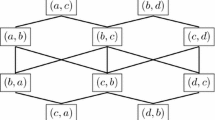Abstract
Let ≽ be a total order on the power set of a finite set [n]. A subset S ⊂ [n] is separable when for any X,Y ⊂ S and any Z ⊂ [n] − S, the ordering of X and Y is the same as the ordering of X ∪ Z and Y ∪ Z. The character of a preference order is the collection of all separable subsets. Motivated by questions in the theories of voting, marketing and social choice, the admissibility problem asks which collections \(\mathcal {C} \subset \mathcal {P}({[n]})\) can arise as characters of preference orders. We introduce a linear algebraic technique to construct preference orders. Each vector in our 2n-dimensional voter basis induces a simple preference preorder (where ties are allowed) with nice separability properties. Given any collection \(\mathcal {C} \subset \mathcal {P}({[n]})\) that contains both ∅ and [n], and such that all pairs of subsets are either nested or disjoint, we use the voter basis to construct a preference order with character \(\mathcal {C}\).
Similar content being viewed by others
Data Availability
Data sharing not applicable to this article as no datasets were generated or analysed during the current study.
References
Barberá, S., Bossert, W., Pattanaik, P.K.: Ordering sets of objects. In: Barberá, S., Hammond, P.J., Seidl, C. (eds.) Handbook of Utility Theory, vol. 2, chapter 17, pp. 893–977. Springer (2004)
Bjorkman, B., Gravelle, S., Hodge, J.K.: Cubic preferences and the character admissibility problem. Math. Soc. Sci. 99, 5–17 (2019)
Bradley, W.J., Hodge, J.K., Kilgour, D.M.: Separable discrete preferences. Math. Soc. Sci. 49(1), 335–353 (2005)
Brams, S.J., Kilgour, D.M., Zwicker, W.S.: Voting on referenda: the separability problem and possible solutions. Elect. Stud. 16, 359–377 (1997)
Christian, R., Conder, M., Slinko, A.: Flippable pairs and subset comparisons in comparative probability orderings. Order 24, 193–213 (2007)
Daugherty, Z., Eustis, A.K., Minton, G., Orrison, M.E.: Voting, the symmetric group, and representation theory. Am. Math. Mon. 116(8), 667–687 (2009)
de Finetti, B.: Sul significato soggetivo della probabilità. Fundam. Math. 17, 298–329 (1931)
Fishburn, P.C.: Finite linear qualitative probability. J. Math. Psychol. 40, 64–77 (1996)
Hodge, J.K.: The mathematics of referendums and separable preferences. Math. Mag. 84(4), 268–277 (2011)
Hodge, J.K., Klima, R.E.: The Mathematics of Voting and Elections: a Hands-on Approach. Volume 22 of Mathematical World. American Mathematical Society, Providence (2005)
Hodge, J.K., Krines, M., Lahr, J.: Preseparable extensions of multidimmensional preferences. Order 26(2), 125–147 (2009)
Hodge, J.K., TerHaar, M.: Classifying interdependence in multidimensional binary preferences. Math. Soc. Sci. 55(2), 190–204 (2008)
Kraft, C.H., Pratt, J.W., Seidenberg, A.: Intuitive probability on finite sets. Ann. Math. Stat. 30, 408–419 (1959)
Lacy, D., Niou, E.M.S.: A problem with referendums. Journal of Theoretical Politics 12(1), 5–31 (2000)
Maclagan, D.: Boolean term orders and the root system bn. Order 15, 279–295 (1999)
Martin, J: Personal communication (2018)
Shocker, A.D., Bayus, B.L., Kim, Namwoon: Product complements and substitutes in the real world: the presence of other products. J. Mark. 68, 28–40 (2004)
Slinko, A.: Additive representability of finite measurement structures. In: Brams, S.J., Gehrlein, W.V., Roberts, F.S. (eds.) The Mathematics of Preference, Choice and Order, pp. 113–133. Springer (2009)
Sloane, N.J.A.: The On-line Encyclopedia of Integer Sequences. https://oeis.org/A005806 (2018)
Acknowledgements
We thank Tom Halverson for many insightful conversations and his help in developing the voter basis; Jeremy Martin for suggesting Lemma 3; and Trung Nguyen and Tuyet-Anh Tran for their careful readings of earlier drafts. We also thank the anonymous referees for their feedback, which has significantly improved the exposition.
Author information
Authors and Affiliations
Corresponding author
Additional information
Publisher’s Note
Springer Nature remains neutral with regard to jurisdictional claims in published maps and institutional affiliations.
Rights and permissions
About this article
Cite this article
Beveridge, A., Calaway, I. The Voter Basis and the Admissibility of Tree Characters. Order 38, 489–514 (2021). https://doi.org/10.1007/s11083-021-09553-8
Received:
Accepted:
Published:
Issue Date:
DOI: https://doi.org/10.1007/s11083-021-09553-8




